Small can be considered tanks with a volume of 3 to 30 liters. There are quite miniature options - 1-2 liter containers, but they do not hold fish in them, but create mini-gardens from aquatic plants with snails. Small tanks are also called nano-aquariums, from the Greek word "tiny." They successfully contain some species of fish.
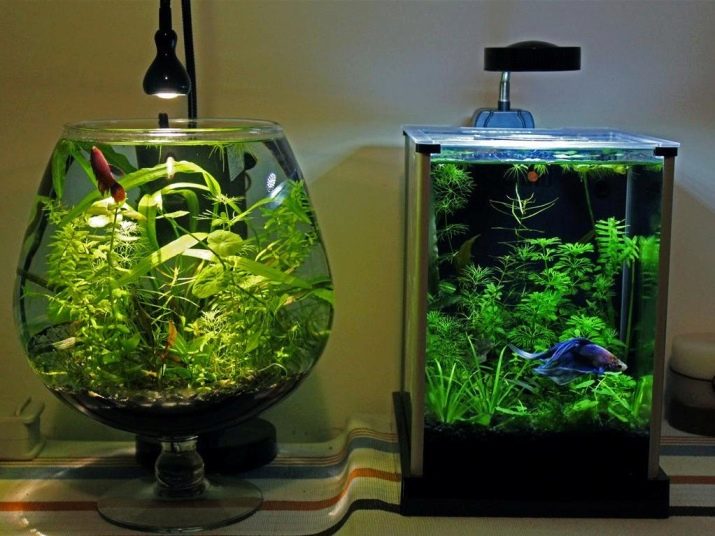
Advantages and disadvantages
At nano-aquariums There are a number of significant advantages:
- low cost - the price of a 10-liter aquarium starts at 600 rubles;
- compactness - it is not necessary to buy a special cabinet for a small aquarium; it can be put on a desk or dressing table;
- light weight - the tank is easy to transport.
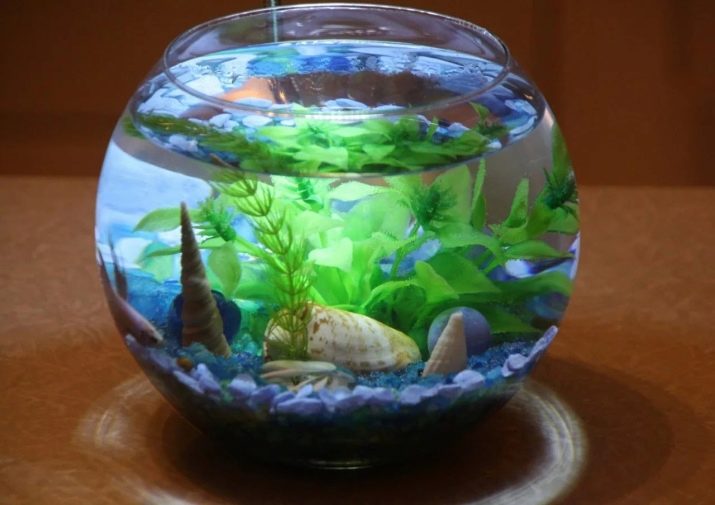
Before you buy a nano-aquarium, you should familiarize yourself with the disadvantages of its contents:
- in an artificial reservoir of small size it is difficult to achieve biological equilibrium, water indicators can be unstable;
- the water environment is more quickly polluted, therefore it is more difficult to take care of the aquarium;
- large fish cannot be kept.
Despite these disadvantages, small unpretentious fish are successfully kept in such volumes. Guppies, neons and males will feel good in a small aquarium, you just need to avoid overpopulation.
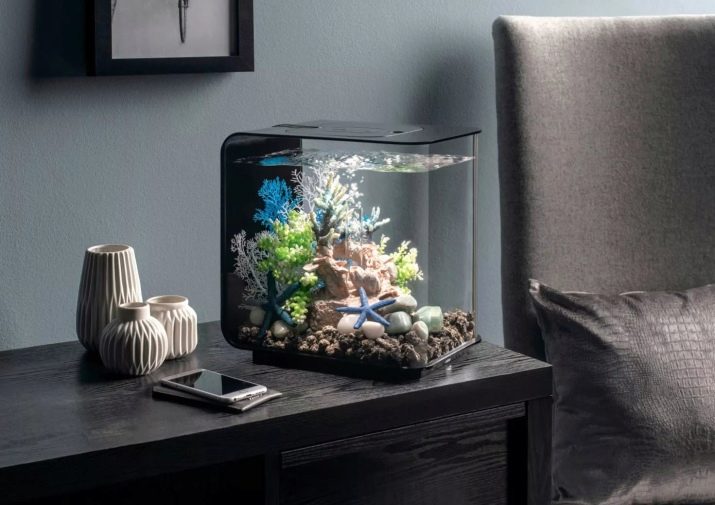
Shape and size options
There are many different forms of nano aquariums. Each breeder will be able to choose the right option for himself.
Rectangular
This is a classic of the aquarium world. In these tanks all kinds of fish feel comfortable. The aspect ratio is most often the following: for a 5-liter - 25 × 13 × 15.5 cm, for a 10-liter - 32 × 15 × 21 cm, for a 20-liter - 36 × 19 × 29, and for a 30-liter - 40 × 23 × 32.
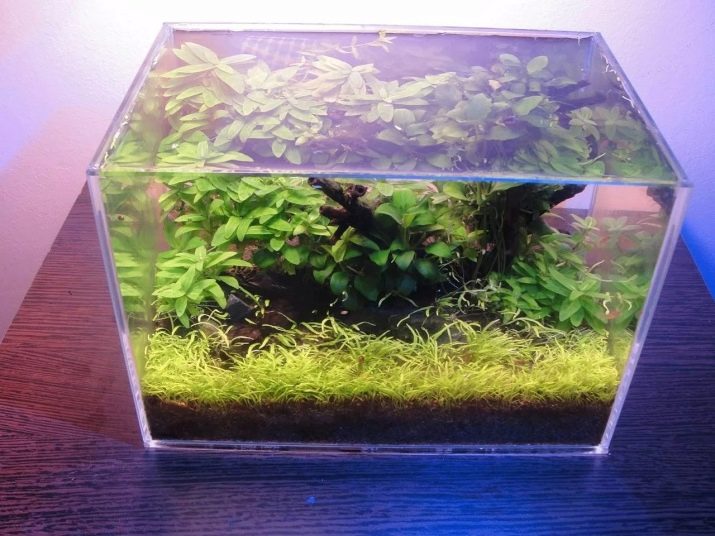
"TVs"
These aquariums are also rectangular in shape, but their front glass is curved. Because of this, the inner image of the underwater world may be distorted. In spite of this, many people like this form, because "TVs" look very beautiful in the interior.
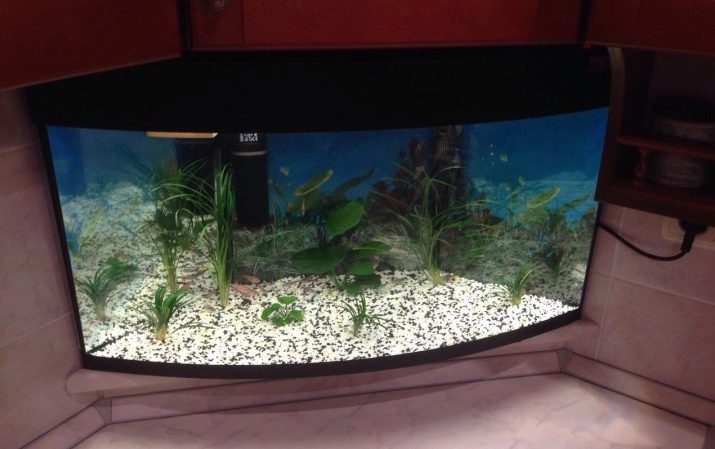
"Panorama"
Rectangular aquarium with beveled corners. Provides a good view, you can enjoy fish from any angle.
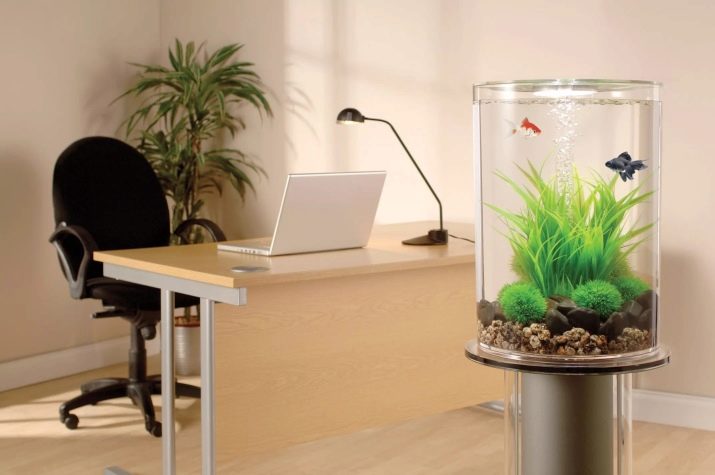
Square
Capacities with equal sides. The size of the 10-liter aquarium is 21 × 21 cm, and the 20-liter aquarium is 27 × 27 cm.

Round
These are aquariums in the shape of a ball or a glass. It is believed that in a tank of this form, it is very uncomfortable for almost all types of fish. Nevertheless, unpretentious fish are successfully kept; it is especially popular to keep a cockerel in a glass.
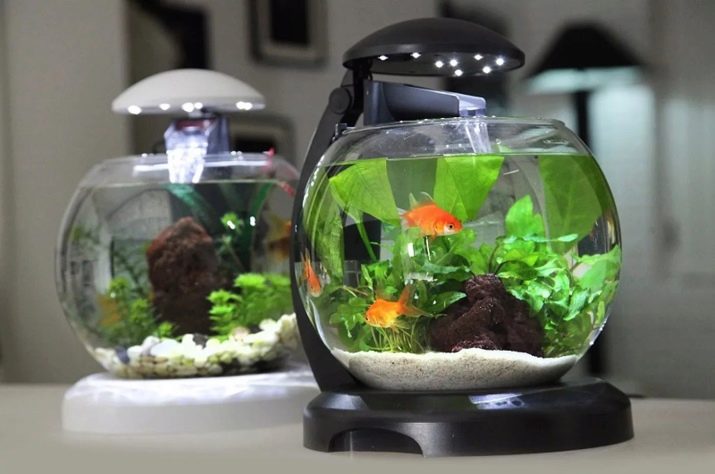
Cylindrical
These are narrow, elongated aquariums. The aspect ratio can be different, some manufacturers make the containers more elongated, others - wider. A cylindrical aquarium, like a round aquarium, is not very convenient for fish, it is especially not recommended to keep catfish in it.
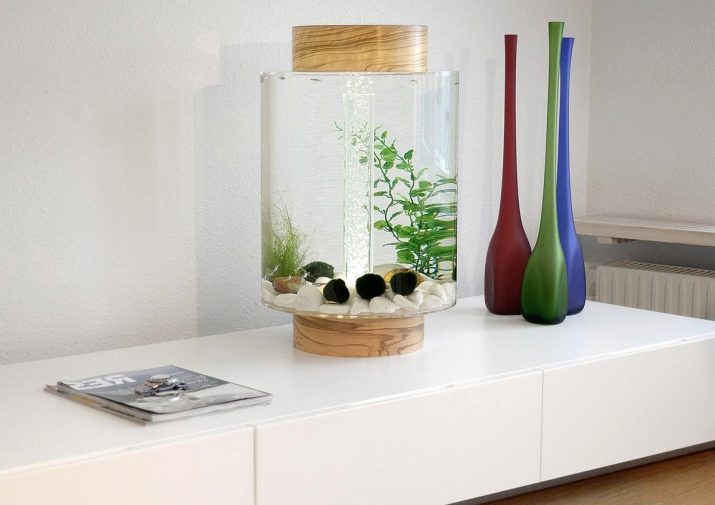
Semicircular
The original form of the aquariums, one side of which is completely flat and straight, and the other is rounded. They look especially interesting if you hang them on the wall.
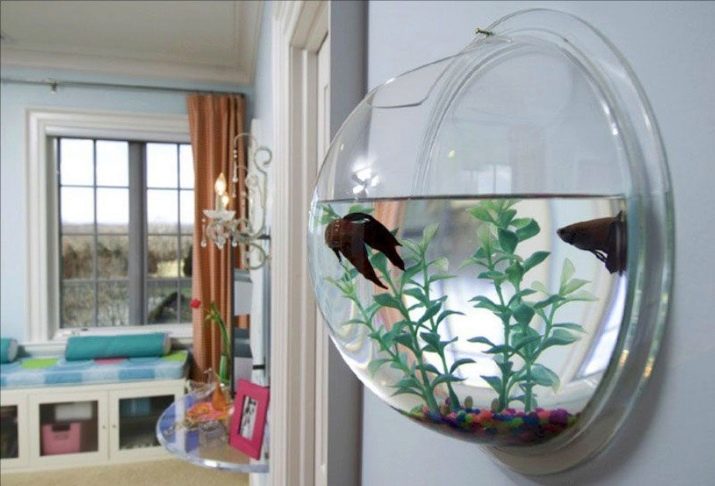
Corner
Compact and comfortable. Such aquariums can be placed in the corner of the desk, they will not take up much space. Among the models there are options with both direct and curved front glass. The approximate dimensions of a 10-liter triangular aquarium are 25 × 25 × 18, and a 30-liter - 34 × 34 × 27.
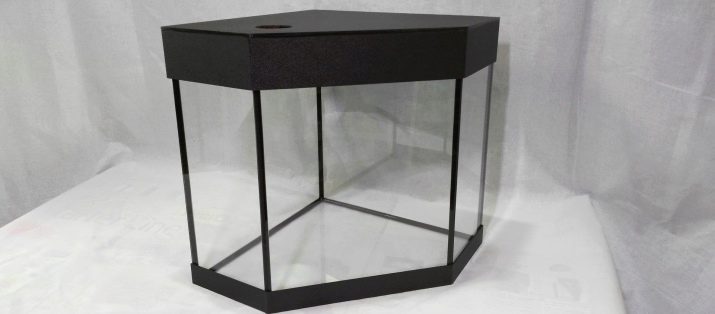
Now there are many aquariums of unusual shape: in the form of a jug, a rhombus, a house. Of particular interest is such a creative option as two cubes connected by a tunnel. Tanks of a similar form are very difficult to equip independently, therefore most often they are sold already fully equipped with all necessary attributes.
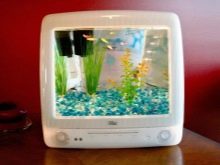
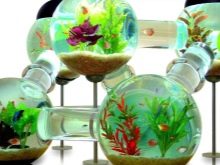
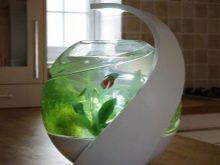
How to choose?
A novice should know that a used aquarium bought from a hand often fails quickly.
If the container has been in operation for a long time, it can leak, and sometimes glass completely bursts in it. Therefore, it is better to purchase an aquarium in a specialized store.
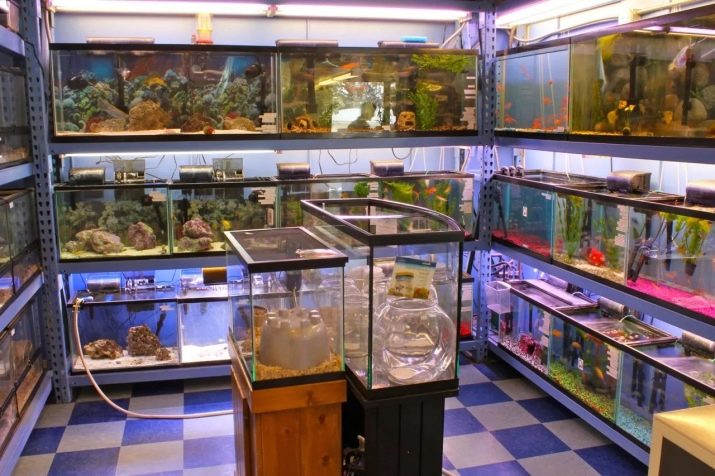
Preference should be given to well-known manufacturers:
- Aquael
- Juwel;
- "Biodesign";
- Tetra;
- Ferplast
When buying an aquarium, you should carefully consider the glass, it is unacceptable to have chips and scratches.
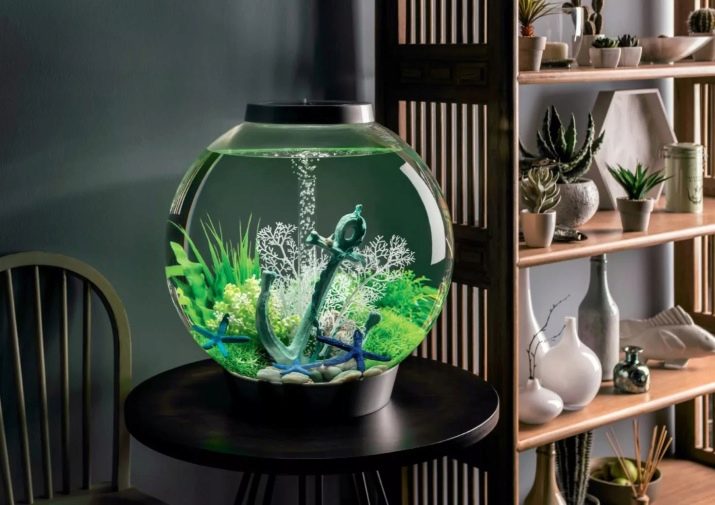
It is important to pay attention to the seams, they should be smooth and without bumps, and traces of sealant cannot be seen. Otherwise, it is better to refuse to purchase low-quality goods, because in place of a poorly processed seam, a leak will necessarily form over time.
The glass thickness of all aquariums with a volume of up to 30 liters should be at least 4 mm. But it is worth paying attention to the type of glass.

Currently, the following materials are used to make aquariums.
- Acrylic - This material perfectly retains heat in the aquarium, in addition, it is durable and lightweight. Of the minuses, it can be noted that scratches quickly form on it, but they are easy to polish.
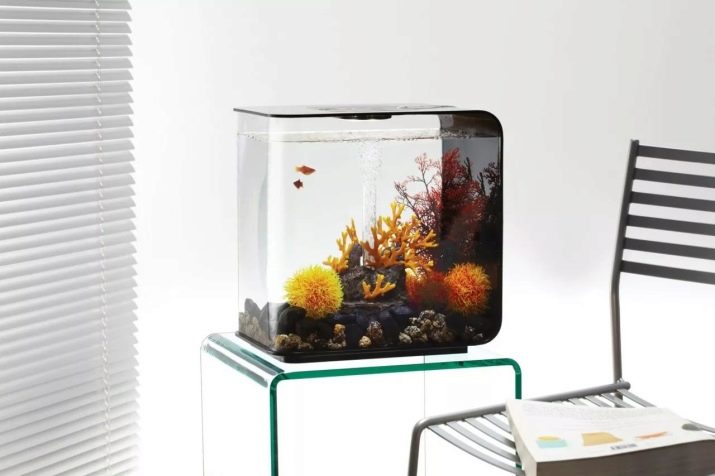
- Organic glass - This is the most popular material for making aquariums. It is cheap and scratch resistant, but is heavy and quite fragile.
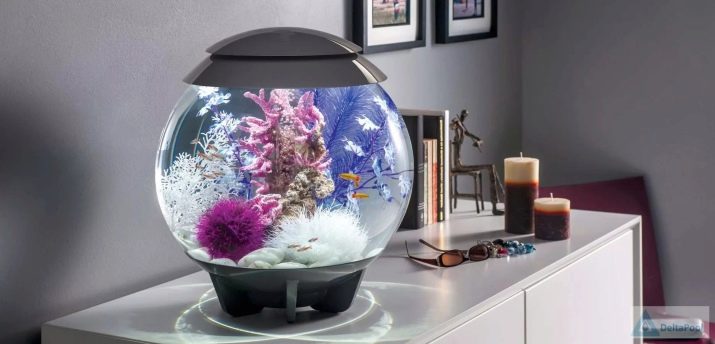
- Float glass - this is a very transparent glass through which it is interesting to observe the underwater life, the picture is transmitted without distortion. Float glass aquariums are not cheap, most often they are made to order.
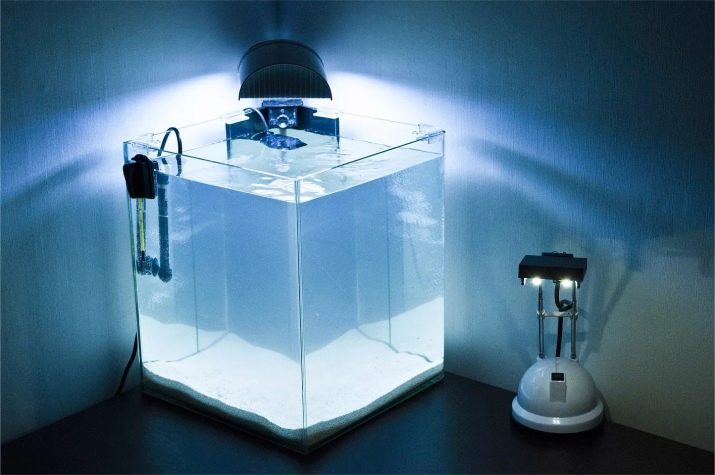
For the house, you can choose a tank of any material, but in public places with a lot of people it is better to install an aquarium of acrylic. It is more durable and if it falls, injuries can be avoided.
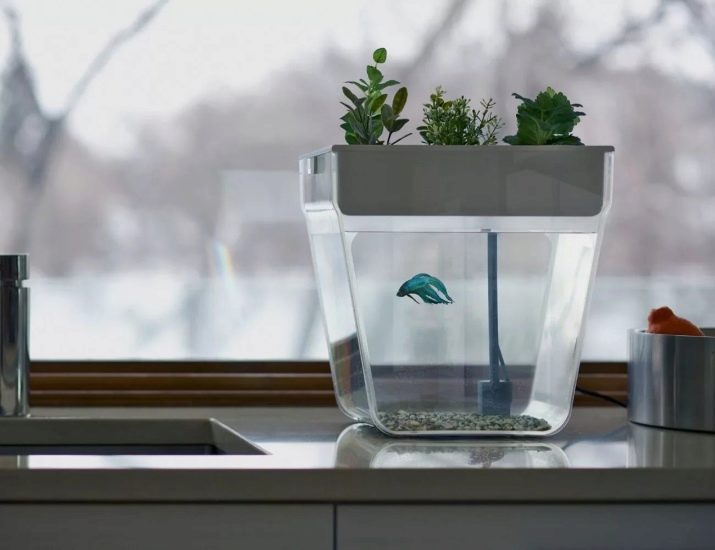
How to equip?
Although the aquarium is small, it must be equipped with all necessary equipment:
- a filter;
- aeration system (compressor);
- a heater;
- lamps.
If you can do without a compressor and a heater, then without a filter - no. Its installation is the most important thing in arranging a small volume aquarium.
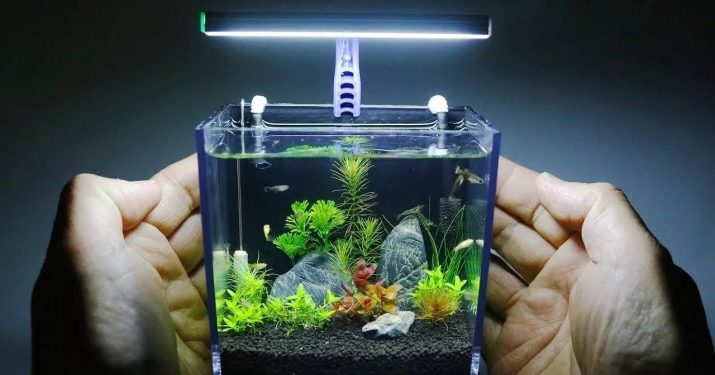
The filtration system will keep the water clean. And this is necessary not only because of aesthetic considerations, but also to maintain the health of fish. All filters are divided into 2 types.
- Internal Placed inside the aquarium. They have a very simple device, but sometimes they create too much water flow. In addition, in a small aquarium they take up a lot of space.
- External Their dimensions are larger than those of the external ones, but such filters are placed outside the aquarium, only the tube is inside the reservoir.
Some filters not only purify water from pollution, but also saturate it with oxygen.
Due to the wind and the current created by it, natural aeration of water occurs in natural reservoirs. In the aquarium, it is necessary to artificially create such a process.
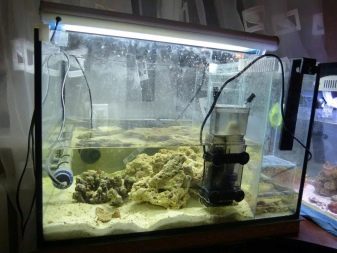
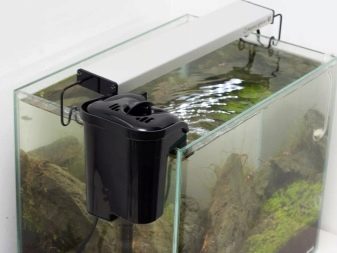
If there is no filter in the aquarium or it does not saturate the water with oxygen, then a compressor is needed. They come in three forms.
- Membrane compressors. Their main advantage is the cost. They are not too powerful, but they are quite suitable for a small aquarium.
- Piston compressors. They have excellent power, which is enough for several aquariums.
- Piezoelectric compressors. Compact and silent, this is the best option for a small aquarium.
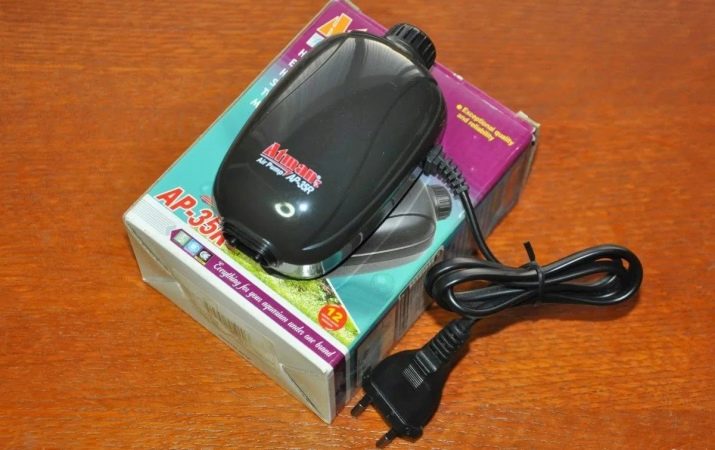
Calculate the required compressor power for a particular tank using the following formula: 0.5-0.8 times the volume of the aquarium. For example, for a 30-liter capacity, a compressor with a capacity of at least 15-24 liters per hour is needed.
You should not buy equipment intended for large artificial reservoirs, because excessive oxygen supply is as harmful to fish as its complete absence.
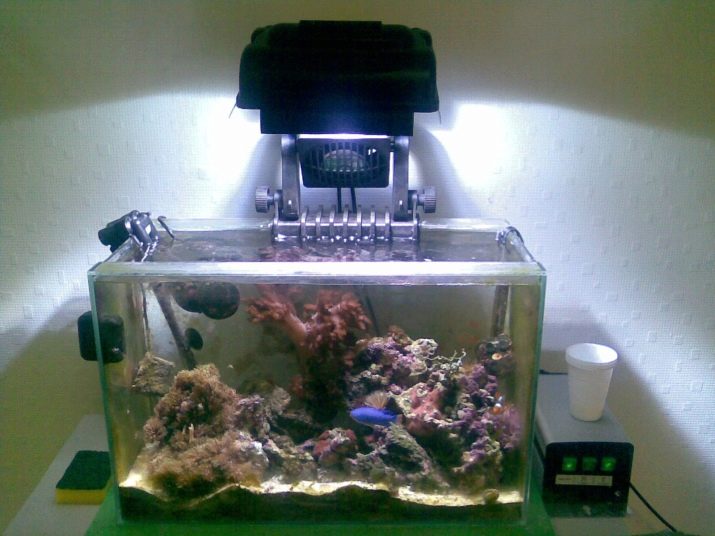
Comfortable temperature for keeping aquarium fish - + 22-28 degrees.
This is an indicative figure, because the conditions of detention of different species may vary slightly. Some fish are very sensitive to water temperature, so a thermometer is installed in the aquarium. If the pond is too cold, then place a heater. It does not take up much space and allows you to maintain a comfortable water temperature for thermophilic fish.

It is important to provide fish with an 8-12-hour light day. In this case, you can not place the aquarium near the window.
Drafts and direct sunlight are harmful to fish and plants. Therefore, the tank is placed at a small distance from the window and equipped with artificial lighting. Fluorescent lamps or LED lights are placed above the pond. In the evening, lighting is always turned off, because some aquatic inhabitants, for example, catfish, prefer a nocturnal lifestyle.

How to issue?
At home, a small aquarium can be decorated in the following ways:
- fill the bottom with soil;
- plant bushes of plants;
- stick on the back wall a beautiful background;
- place driftwood, shells and other decor items.
As the soil, you can use sand, granite chips and pebbles of small and medium size.

It is better to choose a dark background, since on a light fish coloring does not look so impressive. In addition, white soil is very easily soiled, and after a few months, white pebbles can become greenish or dirty gray. Pebbles and sand are carefully poured into the bottom, at least 2 cm thick. Pebbles that are too sharp should be taken away, and fish may be injured on their edges.
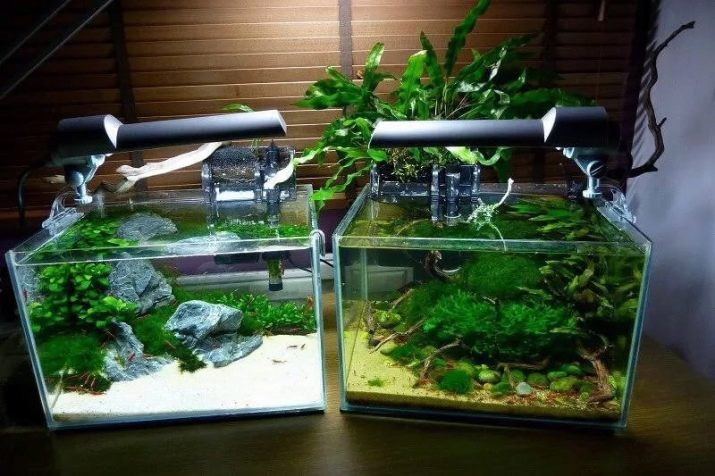
An important function in the aquarium is played by plants. They contribute to the formation of an ecosystem favorable for fish, and for some species of fish serve as a shelter and source of plant food. From algae for a small aquarium, the following types are suitable:
- Wallisneria
- dwarf anubias;
- cryptocorin;
- cladophore;
- riccia;
- didiplis;
- javanese moss;
- bacopa.

Algae is placed according to the following scheme: long grass is planted on the sides or along the rear wall of the aquarium, and in the middle - undersized bushes.
The shape of the aquarium should also be taken into account: for example, in a round or square pond, one bush with long leaves, planted in the center, will best look. You can come up with your own original landing scheme.The main thing is to observe the measure and periodically thin out strongly overgrown plants.
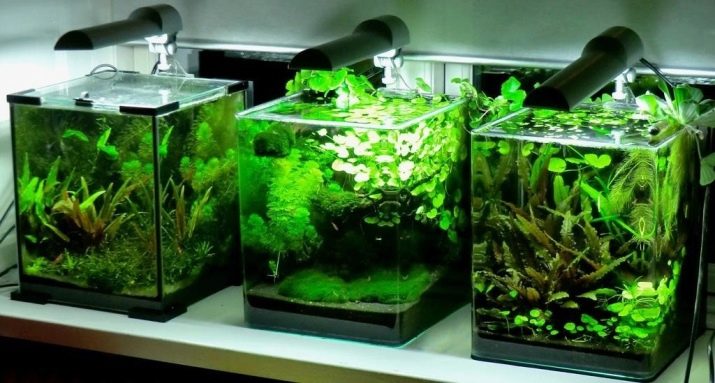
The back wall of the aquarium can be beautifully decorated. For this, there are special films that are glued to the glass. Water surface, sun glare, mountains, forest landscapes, images of sea creatures - such pictures will noticeably transform the aquarium. Volumetric images of stones and rocks look especially impressive. At the bottom you can put driftwood, inverted pottery shards, houses, grottoes. Such jewelry has not only an aesthetic function, but also serves as a reliable shelter for shy fish and fry.
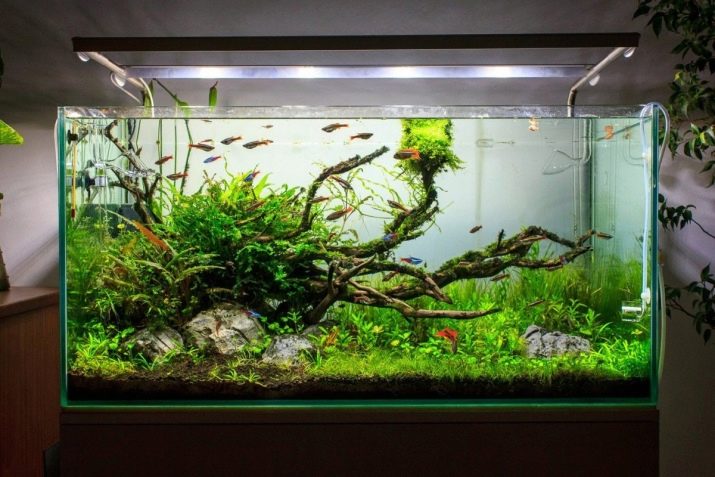
How to contain?
As noted above, caring for a small aquarium is not as simple as it might seem at first glance. The main thing is to keep it clean. For this, every 4-7 days, a quarter of the water is replaced with fresh water. The frequency of change depends on the size of the tank: the smaller it is, the more often the procedure is carried out.
Do not forget about soil cleaning. Using a siphon from the bottom, you can easily remove the waste products of fish.
In small aquariums, soil cleaning can be easily combined with a water change procedure. Indeed, in the process of working with a siphon from the aquarium, about a quarter of the old water is just sucked out, it remains only to add fresh. Decor items must be periodically removed and washed thoroughly. From green fouling, soda can be used, and the decorations are thoroughly cleaned and washed under running water.
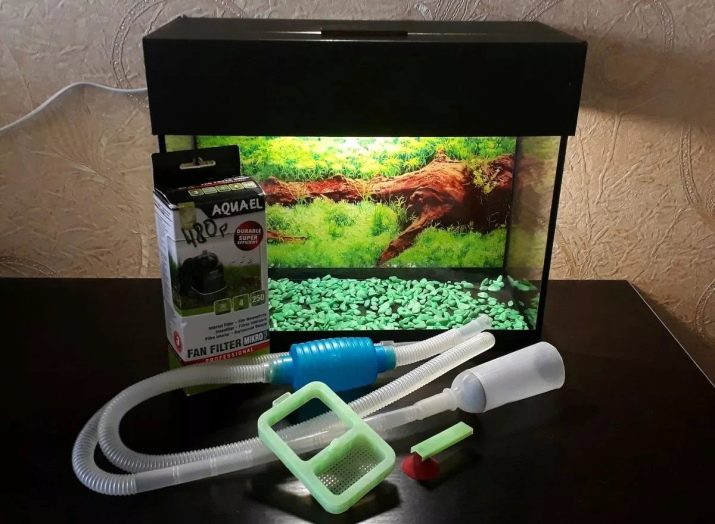
Do not feed the fish too abundantly, it is the remnants of the food that cause severe pollution of the reservoir. An uneaten food rots and releases substances harmful to fish, causing poisoning and other diseases. Therefore, food is given in small portions. It should be eaten in 4-8 minutes, all that remains is to be removed.
Check water parameters. In pet stores you can buy special tests that will determine the stiffness, acidity, the presence of nitrites and nitrates.
It is especially recommended to buy such tests when you first start the aquarium, as well as when changing the appearance of the fish and their unusual behavior. Many diseases of aquarium pets are caused by banal poisoning and inadequate water standards.
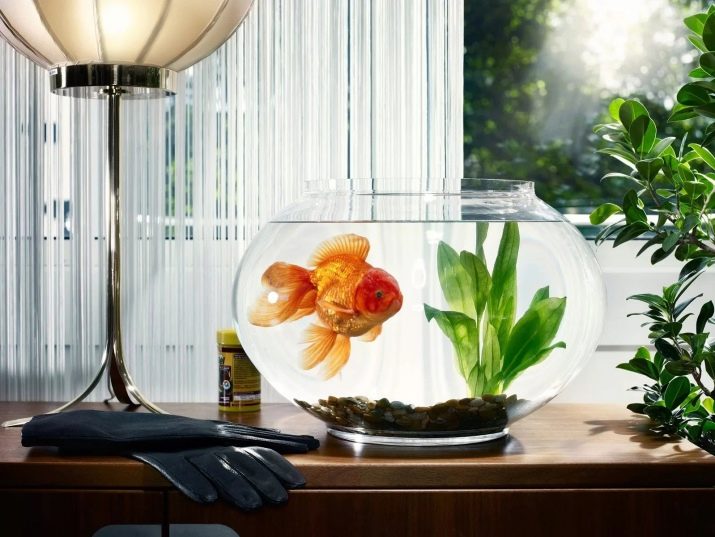
How many and what kind of fish can I keep?
In a small aquarium, it is better to get small fish. Below is a list of the most unpretentious species that can live in a flock in a small space.
- Guppy - The most common aquarium fish. They are not too picky, they are comfortable even in 5-liter jars. In an aquarium with a volume of 10 l, you can put 5-7 individuals.
- Neons - bright flocking look. Up to 5 individuals can be planted in a 10-liter capacity, and about 10 pieces in a 20-liter capacity. The larger the flock, the more comfortable neons feel.
- Danio rerio - a beautiful striped fish. The maximum number of individuals for a 10-liter aquarium is 5-6 pieces.
- Speckled catfish - peaceful good-natured creatures, prefer to live in the lower layer of water. For one individual, 4 liters of water is required. Better to settle in a small group - from 3 individuals.
- Cardinal - active, nimble fish. One individual requires 3 liters of water, but it is better to keep them in a large flock - from 10 pieces. Therefore, they will be comfortable in a 30-liter aquarium.
- Microparsing - a very small fish, grows no more than 2.5 cm in length. 5 individuals can be populated in a 15-liter aquarium; a larger flock can be allowed to enter a larger 30-liter tank - about 10 pieces.
- Pecilia, Swordsmen, Mollinesia Are related species. They are also unpretentious, but grow a little larger than the above-mentioned fish, so the minimum volume of the aquarium for their maintenance is 20-30 liters.
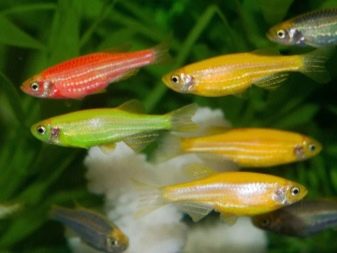

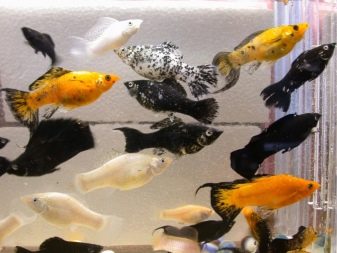
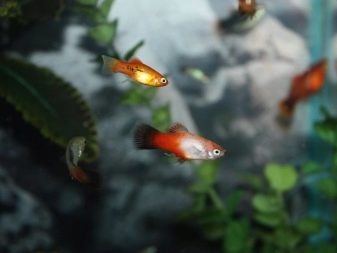
In the nano-aquarium you can put one and a resident. Among the fish there are loners who live perfectly without neighbors.
These include males - fish with gorgeous fins. Males are very pugnacious, therefore it is not recommended to keep two males in one aquarium. Some contain one cockerel in a glass or cube. It looks interesting, but the size of the tank should be at least 5 liters.A mirror can be mounted on the wall of the aquarium. When the male sees his reflection, he becomes brighter and beautifully spreads his fins.
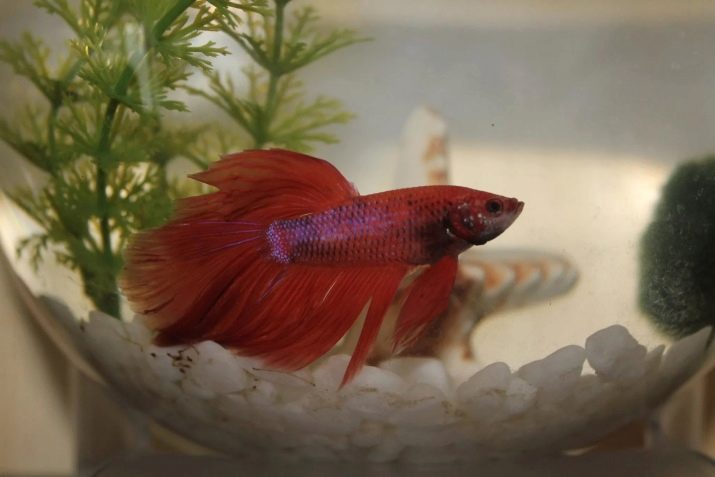
The following video provides step-by-step instructions for caring for a small aquarium.










